The Change in the Shape Characteristics of the Plastic Zone in the Surrounding Rock of an Auxiliary Retracement Channel and a Reasonable Channel Spacing Determination Method
Abstract
:1. Introduction
2. Engineering Background
2.1. Engineering Situations
2.2. Problems in Production
2.3. Geological Conditions
3. Analysis of the Plastic Zone Characteristics in the Rock Surrounding the Auxiliary Retracement Channel
3.1. Evolution of the Shape of the Plastic Zone in the Nonuniform Stress Field in the Roadway Surrounding Rock
3.1.1. Mechanical Model of a Nonuniform Stress Field in a Circular Roadway
3.1.2. Evolution of the Shape of the Surrounding Rock Plastic Zone in the Deviatoric Stress Environment
3.1.3. Relationship between the Principal Stress Direction and the Shape Characteristics of the Plastic Zone
3.2. Migration Law of the Mining Stress Field in front of the Working Face
3.3. Shape Characteristics of the Plastic Zone in the Auxiliary Retracement Channel during the End of the Mining Period
4. Numerical Simulation Analysis
4.1. Numerical Simulation Model
4.2. Distribution of the Mining Stress Field in front of the Working Face
4.3. Shape Characteristics of the Plastic Zone in the Surrounding Rock of the Auxiliary Retracement Channel in the Deviatoric Stress Environment
5. Results and Discussion
5.1. Influence of the Plastic Zone Shape on the Stability of the Auxiliary Retracement Channel
5.2. Method for Determining the Reasonable Spacing of Two Retracement Channels
5.3. Engineering Application Effect Analysis
6. Conclusions
Author Contributions
Funding
Institutional Review Board Statement
Informed Consent Statement
Data Availability Statement
Conflicts of Interest
References
- Ju, Y.; Wang, Y.; Su, C.; Zhang, D.; Ren, Z. Numerical analysis of the dynamic evolution of mining-induced stresses and fractures in multilayered rock strata using continuum-based discrete element methods. Int. J. Rock Mech. Min. Sci. 2019, 113, 191–210. [Google Scholar] [CrossRef]
- Fei, L.; Jiang, Z. Research on Deformation Mechanism of Retracement Channel during Fully Mechanized Caving Mining in Superhigh Seam. Adv. Civ. Eng. 2018, 2018, 1368965. [Google Scholar] [CrossRef]
- Zhang, F.; Wang, X.; Bai, J.; Wu, W.; Wu, B.; Wang, G. Fixed-length roof cutting with vertical hydraulic fracture based on the stress shadow effect: A case study. Int. J. Min. Sci. Technol. 2022, 32, 295–308. [Google Scholar] [CrossRef]
- Malashkevych, D.; Petlovanyi, M.; Sai, K.; Zubko, S. Research into the coal quality with a new selective mining technology of the waste rock accumulation in the mined-out area. Min. Miner. Depos. 2022, 16, 103–114. [Google Scholar] [CrossRef]
- Vu, T.T. Solutions to prevent face spall and roof falling in fully mechanized longwall at underground mines, Vietnam. Min. Miner. Depos. 2022, 16, 127–134. [Google Scholar] [CrossRef]
- Lou, J.; Gao, F.; Yang, J.; Ren, Y.; Li, J.; Wang, X.; Yang, L. Characteristics of evolution of mining-induced stress field in the longwall panel: Insights from physical modeling. Int. J. Coal Sci. Technol. 2021, 8, 938–955. [Google Scholar] [CrossRef]
- Zhao, H.; Cheng, H.; Ji, D.; Wang, T.; Wang, Y.; Jiang, C. Study of the mechanism and evolution law of unsymmetrical failure of the mining roadway in close distance coal seam. Int. J. Min. Sci. Technol. 2021, 50, 1029–1040+1050. [Google Scholar] [CrossRef]
- Li, W.; Tu, S.; Tu, H.; Li, Y.; Liu, X.; Miao, K. Failure characteristics and control techniques for mining roadway affected by stress accumulation of residual pillars in contiguous coal seams. Eng. Fail. Anal. 2022, 141, 106646. [Google Scholar] [CrossRef]
- Wu, R.; Zhang, P.; Kulatilake, P.H.; Luo, H.; He, Q. Stress and deformation analysis of gob-side pre-backfill driving procedure of longwall mining: A case study. Int. J. Coal Sci. Technol. 2021, 8, 1351–1370. [Google Scholar] [CrossRef]
- Suchowerska, A.; Merifield, R.; Carter, J. Vertical stress changes in multi-seam mining under supercritical longwall panels. Int. J. Rock Mech. Min. Sci. 2013, 61, 306–320. [Google Scholar] [CrossRef]
- Babets, D.; Sdvyzhkova, O.; Hapieiev, S.; Shashenko, O.; Vasyl, V. Multifactorial analysis of a gateroad stability at goaf interface during longwall coal mining—A case study. Min. Miner. Depos. 2023, 17, 9–19. [Google Scholar] [CrossRef]
- Zhao, Z.Q.; Ma, N.J.; Liu, H.; Guo, X.F. A butterfly failure theory of rock mass around roadway and its application prospect. J. China Univ. Min. Technol. 2018, 47, 969–978. [Google Scholar] [CrossRef]
- Guo, X.; Ma, N.; Zhao, X.; Zhao, Z.; Li, Y. General shapes and criterion for surrounding rock mass plastic zone of round roadway. J. China Coal Soc. 2016, 41, 1871–1877. [Google Scholar] [CrossRef]
- Ma, N.; Zhao, X.; Zhao, Z.; Li, J.; Guo, X. Stability analysis and control technology of mine roadway roof in deep mining. J. China Coal Soc. 2015, 40, 2287–2295. [Google Scholar] [CrossRef]
- Smoliński, A.; Malashkevych, D.; Petlovanyi, M.; Rysbekov, K.; Lozynskyi, V.; Sai, K. Research into impact of leaving waste rocks in the mined-out space on the geomechanical state of the rock mass surrounding the longwall face. Energies 2022, 15, 9522. [Google Scholar] [CrossRef]
- Wang, B.; Dang, F.; Chao, W.; Miao, Y.; Li, J.; Chen, F. Surrounding rock deformation and stress evolution in pre-driven longwall recovery rooms at the end of mining stage. Int. J. Coal Sci. Technol. 2019, 6, 536–546. [Google Scholar] [CrossRef]
- He, Y.; Song, Y.; Shi, Z.; Li, J.; Chen, K.; Li, Z. Study on failure mechanism of withdrawal channel’s surrounding rock during last mining period. China Saf. Sci. J. 2022, 32, 158. [Google Scholar] [CrossRef]
- Li, C.; Guo, X.; Huo, T.; Liu, R. Coal pillar design of pre-excavated double equipment withdrawal channel and its surrounding rock stability control. J. Huazhong Univ. Sci. Technol. 2021, 49, 1–7. [Google Scholar] [CrossRef]
- LV, H.-W. The mechanism of stability of predriven rooms and the practical techniques. J. China Coal Soc. 2014, 39, 50–56. [Google Scholar] [CrossRef]
- He, F.; Lv, K.; Li, X.; Qin, B.; Li, L. Failure mechanism and control of lower retracement channel in close-distance double-thick coal seams. Shock. Vib. 2021, 2021, 1–19. [Google Scholar] [CrossRef]
- Guo, Y.; Yu, H. Research and application of roof cutting and pressure release technology of retracement roadway in large height mining working face. Geotech. Geol. Eng. 2021, 39, 1289–1298. [Google Scholar] [CrossRef]
- Gu, S.; Wang, B.; Huang, R.; Miao, Y. Method for determining the load on and width of coal pillar at the recovery room end of fully-mechanized longwall mining. J. China Univ. Min. Technol. 2015, 44, 990–995. [Google Scholar] [CrossRef]
- Zhao, Z. Study on Mechanism and Control Method of Deformation and Failure of Surrounding Rock in Large Deformation Mining Roadway; China University of Mining and Technology: Beijing, China, 2014; pp. 26–32. [Google Scholar]
- Guo, X.; Zhao, Z.; Gao, X.; Wu, X.; Ma, N. Analytical solutions for characteristic radii of circular roadway surrounding rock plastic zone and their application. Int. J. Min. Sci. Technol. 2019, 29, 263–272. [Google Scholar] [CrossRef]
- Qian, M.; Shi, P.; Xu, J. Mining Pressure and Strata Control; China University of Mining and Technology Press: Xuzhou, China, 2010; pp. 98–101. [Google Scholar]
- Han, Y.; Wang, Z.; Tang, Y. Principal stress rotation in longwall top-coal caving face adjacent to the gob. J. China Coal Soc. 2020, 45 (Suppl. S1), 12–22. [Google Scholar] [CrossRef]
- Wang, J.C.; Wang, Z.H.; Yang, S.L. Stress analysis of longwall top-coal caving face adjacent to the gob. Int. J. Min. Reclam. Environ. 2020, 34, 476–497. [Google Scholar] [CrossRef]
- Tao, Z.; Song, Z.; He, M.; Meng, Z.; Pang, S. Principles of the roof cut short-arm beam mining method (110 method) and its mining-induced stress distribution. Int. J. Min. Sci. Technol. 2018, 28, 391–396. [Google Scholar] [CrossRef]
- LI, F. Research on the Technology of Upper and Lower Simultaneous Mining in Shallow Thin Bedrock Coal Seam; China University of Mining and Technology: Beijing, China, 2013. [Google Scholar]
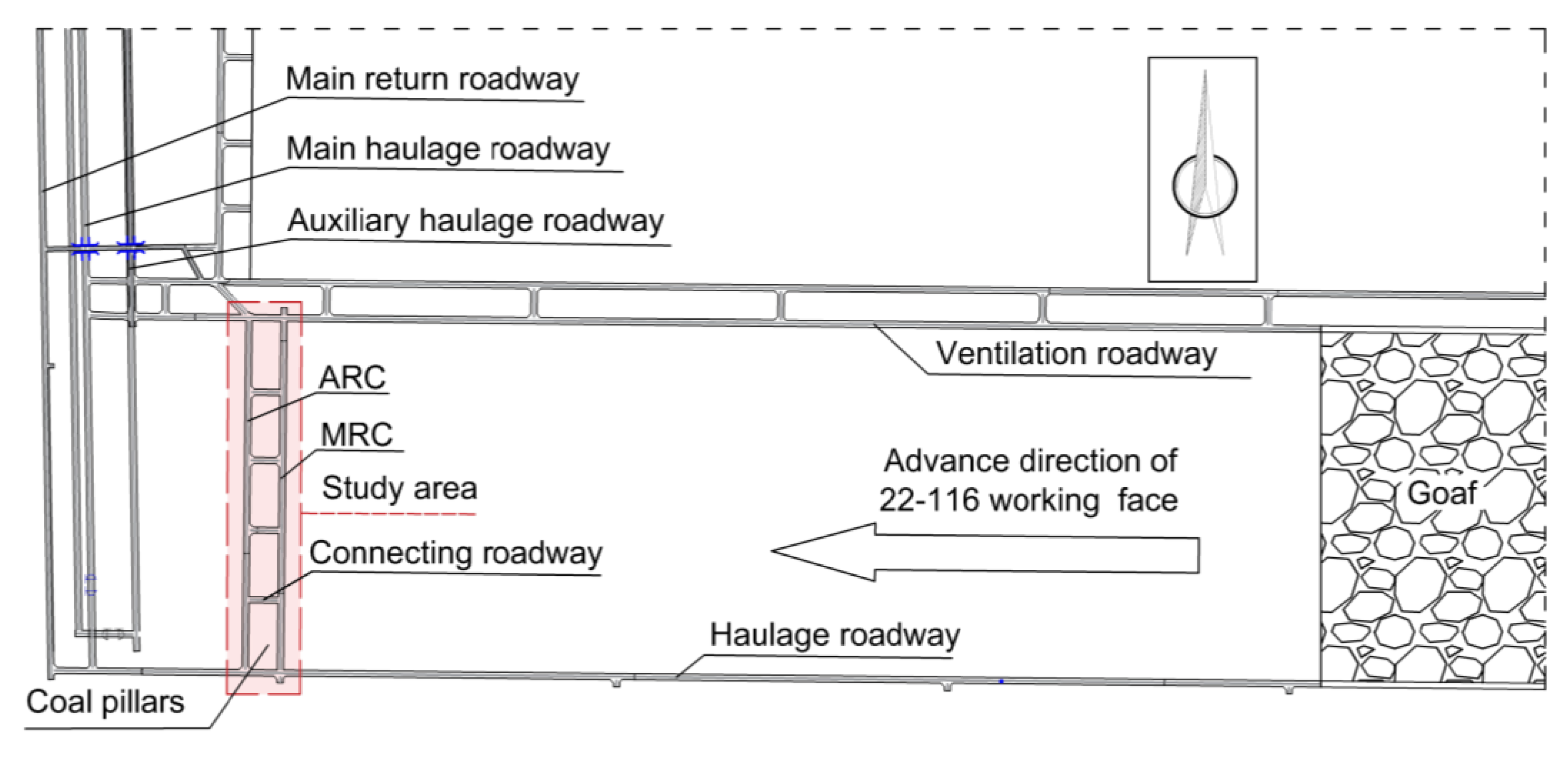


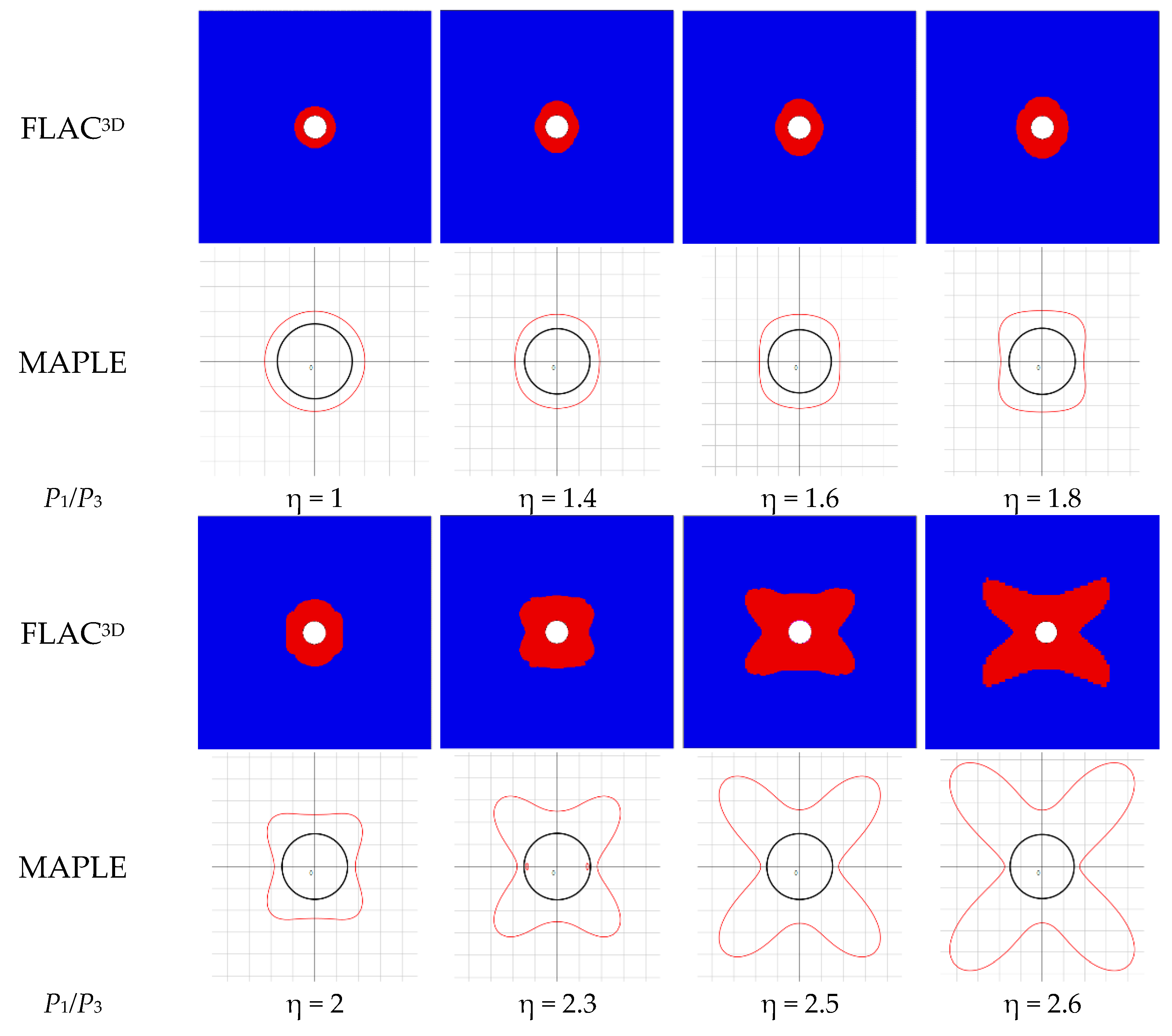

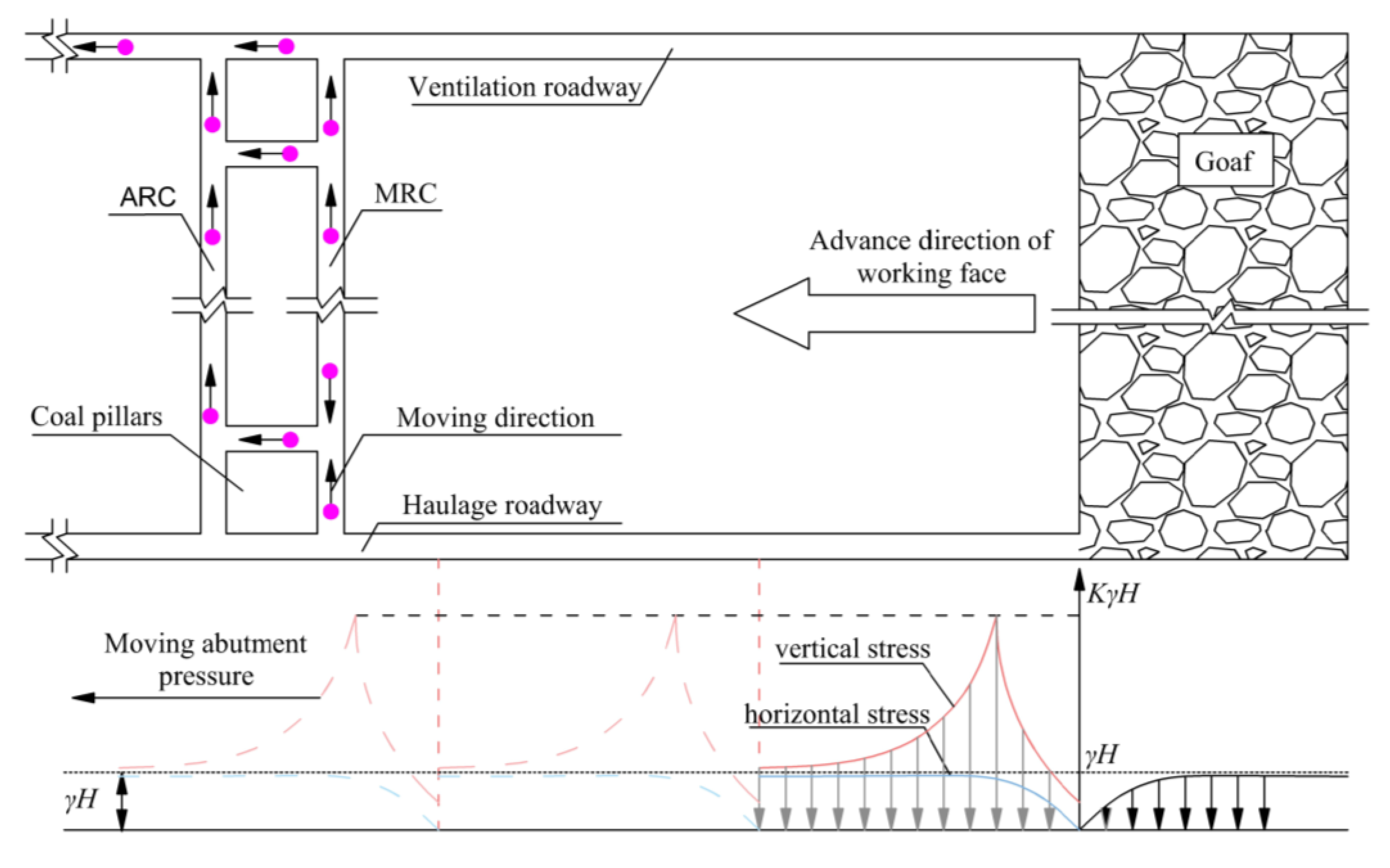

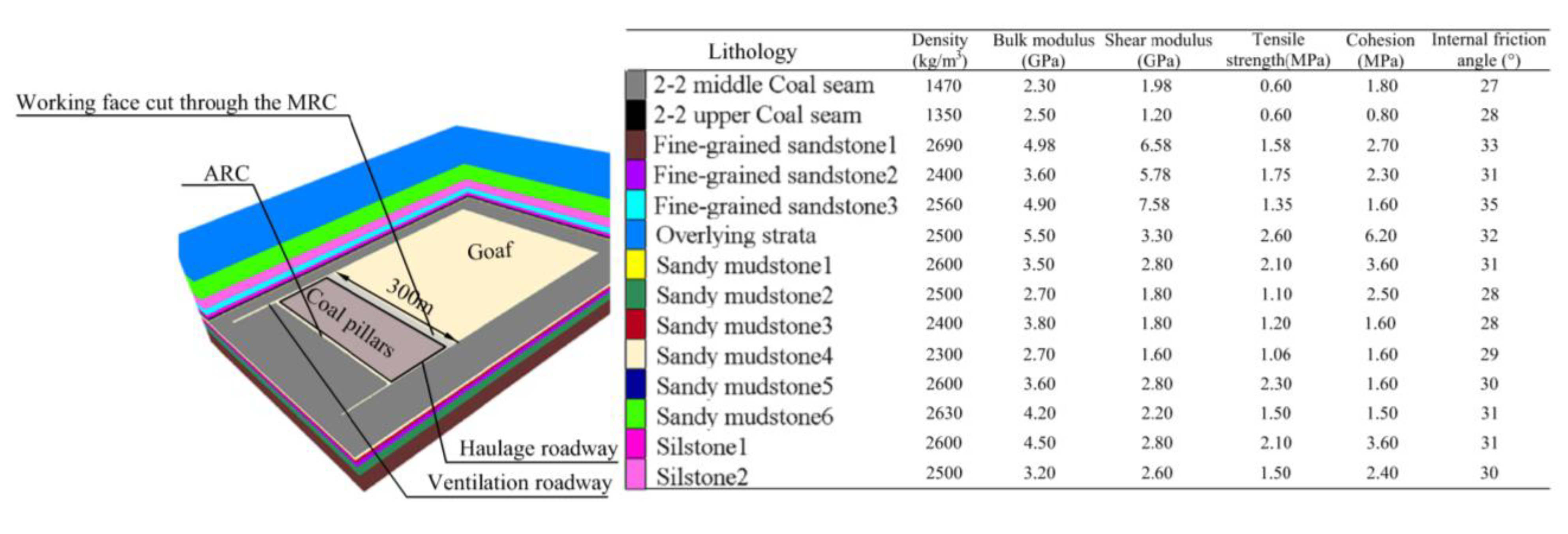
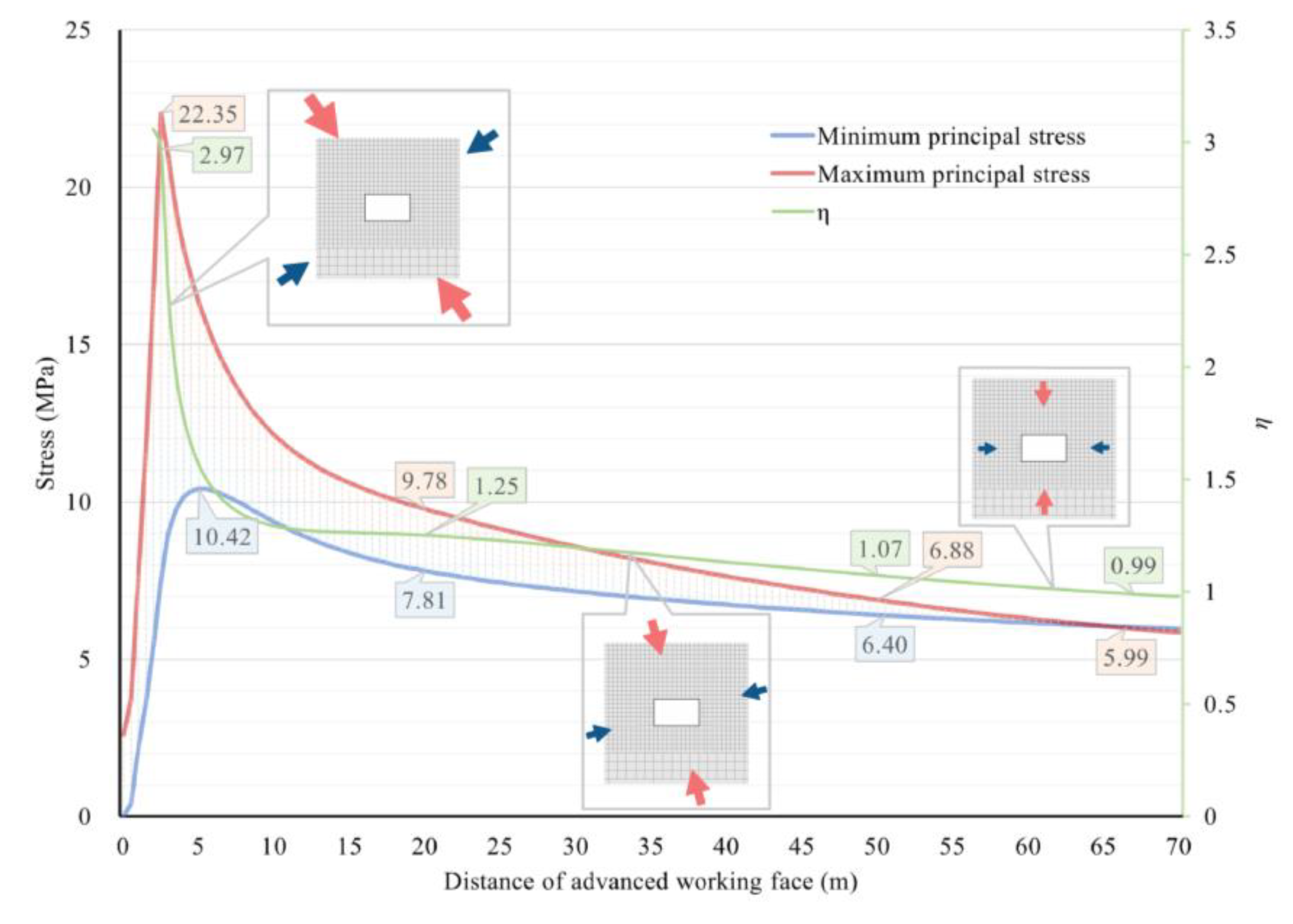
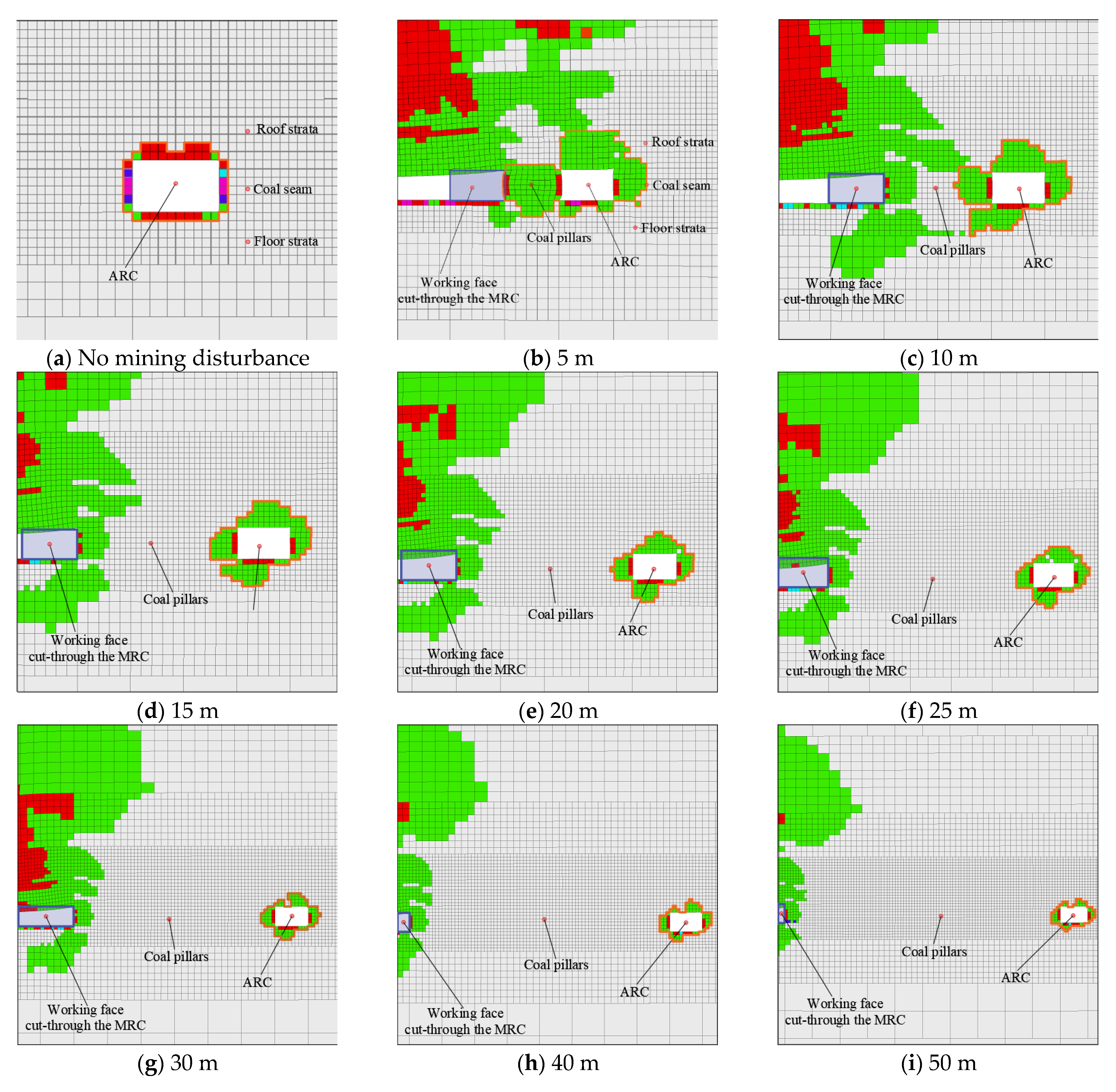

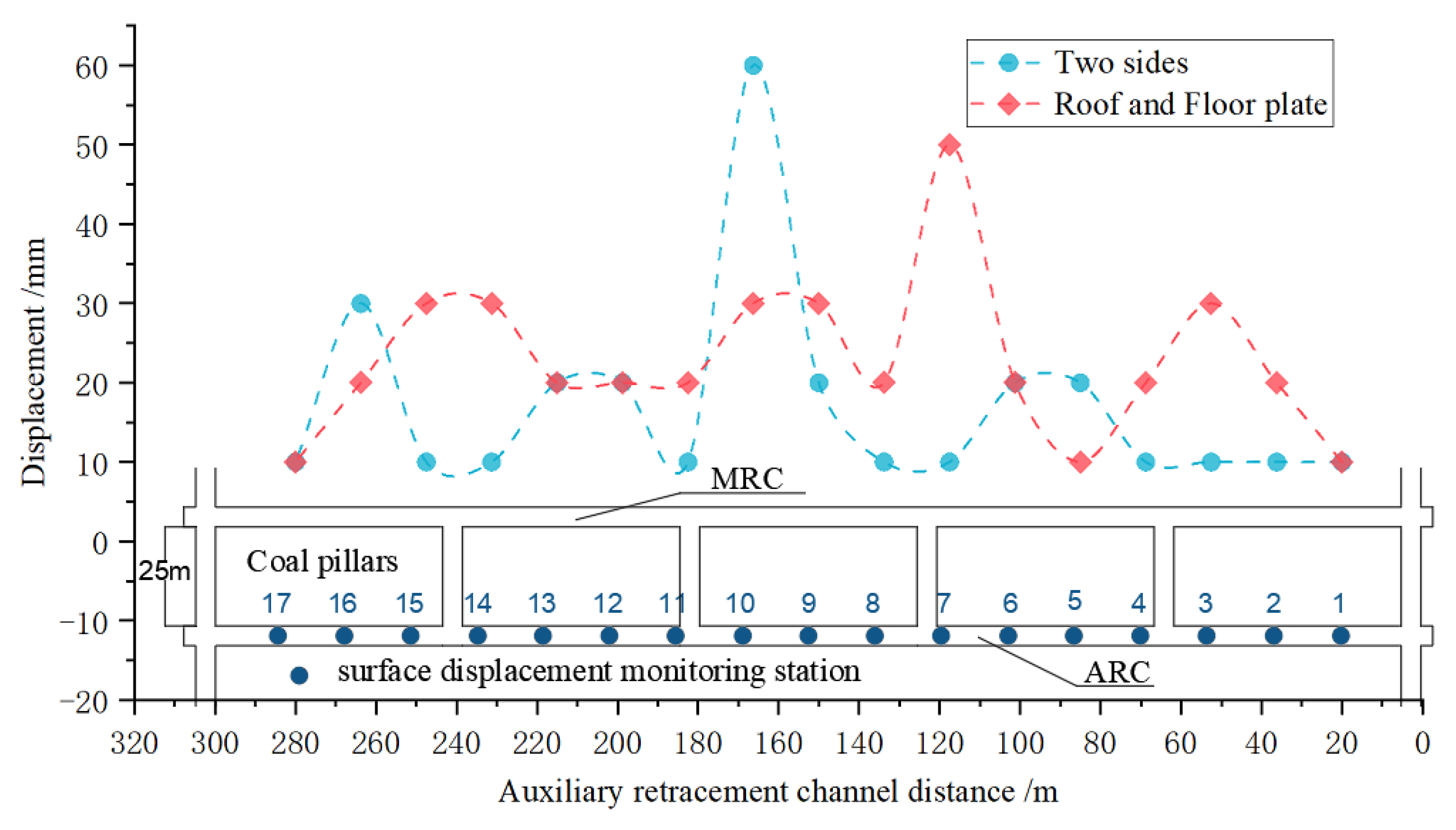
Disclaimer/Publisher’s Note: The statements, opinions and data contained in all publications are solely those of the individual author(s) and contributor(s) and not of MDPI and/or the editor(s). MDPI and/or the editor(s) disclaim responsibility for any injury to people or property resulting from any ideas, methods, instructions or products referred to in the content. |
© 2023 by the authors. Licensee MDPI, Basel, Switzerland. This article is an open access article distributed under the terms and conditions of the Creative Commons Attribution (CC BY) license (https://creativecommons.org/licenses/by/4.0/).
Share and Cite
Gao, X.; Liu, C.; Zhang, H.; Yang, K.; Hu, Y.; Guo, X. The Change in the Shape Characteristics of the Plastic Zone in the Surrounding Rock of an Auxiliary Retracement Channel and a Reasonable Channel Spacing Determination Method. Appl. Sci. 2023, 13, 10543. https://doi.org/10.3390/app131810543
Gao X, Liu C, Zhang H, Yang K, Hu Y, Guo X. The Change in the Shape Characteristics of the Plastic Zone in the Surrounding Rock of an Auxiliary Retracement Channel and a Reasonable Channel Spacing Determination Method. Applied Sciences. 2023; 13(18):10543. https://doi.org/10.3390/app131810543
Chicago/Turabian StyleGao, Xu, Chenyi Liu, Hongkai Zhang, Kunlin Yang, Yingjie Hu, and Xiaofei Guo. 2023. "The Change in the Shape Characteristics of the Plastic Zone in the Surrounding Rock of an Auxiliary Retracement Channel and a Reasonable Channel Spacing Determination Method" Applied Sciences 13, no. 18: 10543. https://doi.org/10.3390/app131810543
APA StyleGao, X., Liu, C., Zhang, H., Yang, K., Hu, Y., & Guo, X. (2023). The Change in the Shape Characteristics of the Plastic Zone in the Surrounding Rock of an Auxiliary Retracement Channel and a Reasonable Channel Spacing Determination Method. Applied Sciences, 13(18), 10543. https://doi.org/10.3390/app131810543



